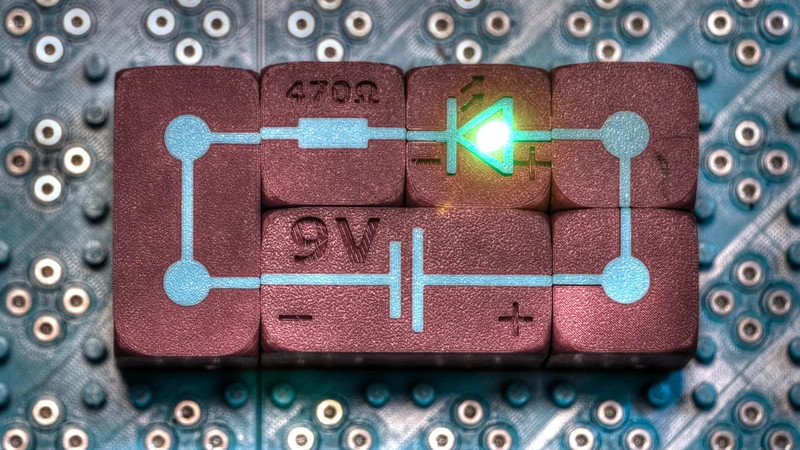Many hackers learned about electronics over the years with home experimenter kits from Radio Shack and its ilk. Eschewing soldering for easier screw or spring based connections, they let the inexperienced build circuits with a minimum of fuss, teaching them the arcane ways of the electron along the way. [victorqedu] has put a modern spin on the form, with his Electric Puzzle Game.
The build consists of a series of 3D printed blocks, each containing a particular electronic component or module. The blocks can be joined together to form circuits, with magnets in the blocks mating with screws in the motherboard to hold everything together and make electrical contact between the parts. It’s a project that requires a significant amount of 3D printing and upfront assembly to build, but it makes assembling circuits a cinch.
The variety of circuits that can be built is impressive. [victorqedu] shows off everything from simple LED and switch arrangements to touch sensors and even a low-powered “Tesla coil”. We imagine playing with the blocks and snapping circuits into place would be great fun. We’ve seen other unconventional approaches before, too – such as building squishy circuits for educational purposes. Video after the break.
















OK, where is the kickstarter, I want to buy a kit.
Very nice build but so much work if you’re hand build it. These remind me of Denshi Blocks.
Denshi blocks?
Exactly my first thought!
Oh, I nearly forgot about those.
I have a Gakken EX-150 which my brother gave me. I think he bought it in the late 70’s.
These have been around for a while…..my nephew had a set.
https://www.amazon.com/Snap-Circuits-SC-300-Electronics-Exploration/dp/B0000683A4
Around for a while? Try around for like 40+ years:
https://upload.wikimedia.org/wikipedia/commons/thumb/c/c0/Egger-Lectron.jpg/1024px-Egger-Lectron.jpg
https://en.wikipedia.org/wiki/Raytheon_Lectron :
“The Lectron electronic blocks system and product was the exclusive and unique invention of Georg Greger in the early 1960s.”
I still have my set. I got it in the sixties when I was a kid, found it in my parent attic.
Every couple of years like clockwork someone has released a new better version, you see them all in the what’s new columns in 70s 80s 90s Electronics magazines. The one in the tech lab at school was approx file card sized green boards, with power rails top and bottom, “signal” line in the middle, screwed together with 4mm terminals I think, was a few decades ago. Trying to remember the name is like trying to trap a greased marble with one finger. Think manufacturer was a name we’d still recognise.
However, this one has the particular advantage that you can print new blocks yourself and add other components easily.
I miss those kits. This is cool, reminds me of the (German?) product Lectron.
https://en.wikipedia.org/wiki/Raytheon_Lectron
Raytheon Lectron https://en.wikipedia.org/wiki/Raytheon_Lectron
I had that (here called “Braun Lectron”) in the 70s and it was an enduring pain of contact problems for really too much money. Definitely more disappointing than useful!
Luckily I soon was able to make my own (breakout-)boards system.
This was my first electronic projects back in 1980s
https://www.youtube.com/watch?v=bA1QE0YI6ZM
I have this in ideal condition if anyone interested.
https://www.petervis.com/electronics-lab/gakken-ex-system/skilcraft-electronic-experiment-set.html
https://www.petervis.com/electronics-lab/gakken-ex-system/skilcraft-electronic-experiment-set/skilcraft-ex-system-box.gif
Someone here in Germany is making similar block-based kits, and well enough that they can build radio circuits. “R-something”… I’ve seen them at maker gatherings. Anyone have a link?
Thames & Kosmos makes one too. Just FYI.
https://www.amazon.com/Thames-Kosmos-Electronics-Learning-Circuits/dp/B004UU3R1U
https://images-na.ssl-images-amazon.com/images/I/81xL0bPbj5L._AC_SL1500_.jpg
I was only thinking about this sort of thing the other day, I cut my electronics teeth on exactly one of these https://www.ebay.com/itm/Vintage-75-In-1-Science-Fair-Electronic-Project-Kit-By-Radio-Shack/233635248057 Now I only dabble in electronics these days as a software dev for full time work but it gave me the bug to investigate and play.
In Poland they have El-Go sets, which were actually used in some schools…
https://www.google.com/search?q=zestaw+el-go&safe=off
I had these when I was a kid in the 60’s. It was the Lectron kit made by Raytheon in the US.
https://en.wikipedia.org/wiki/Raytheon_Lectron
where esp32, stm, microbit, where screen, power for lipo, solar panels etc
i need usb and keyboard, wifi etc,